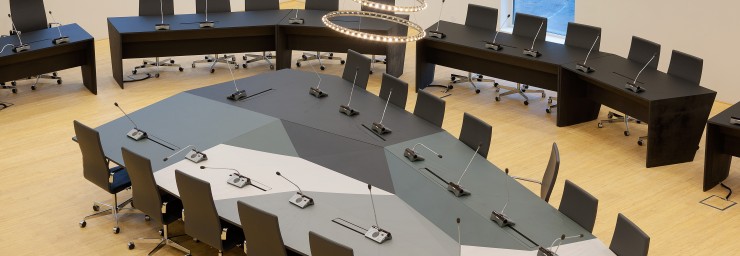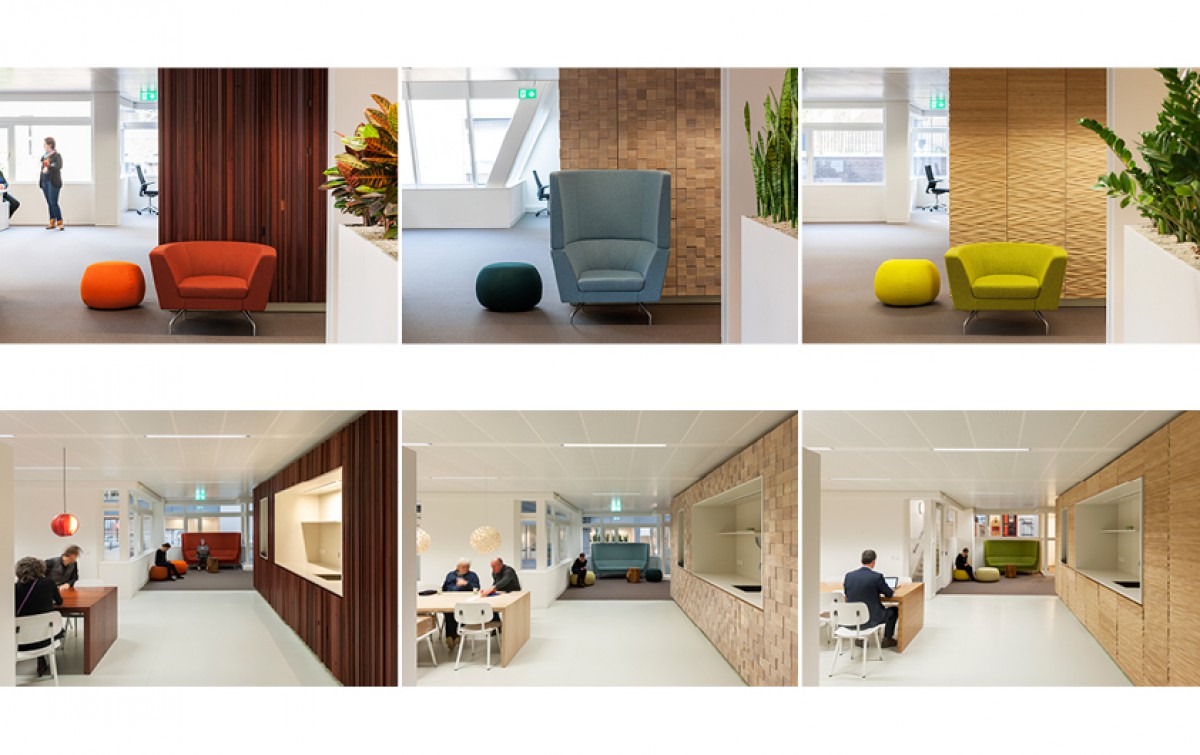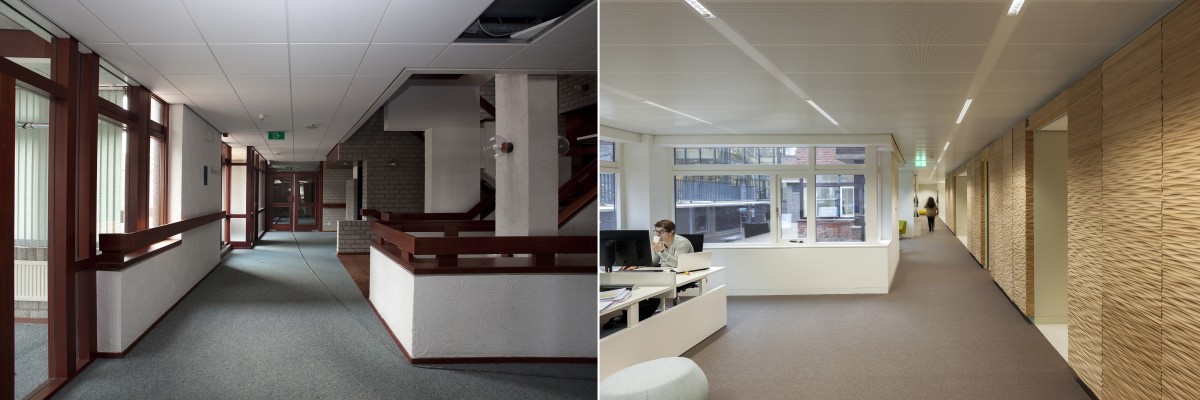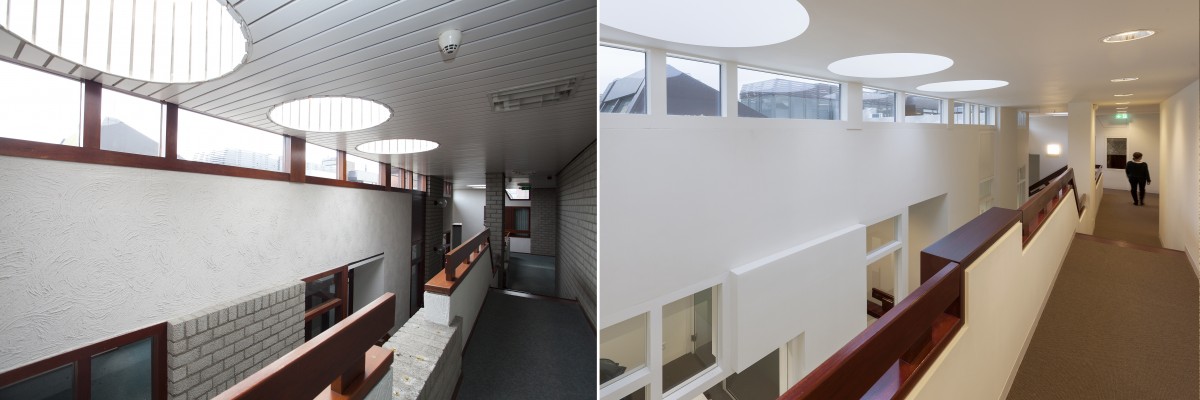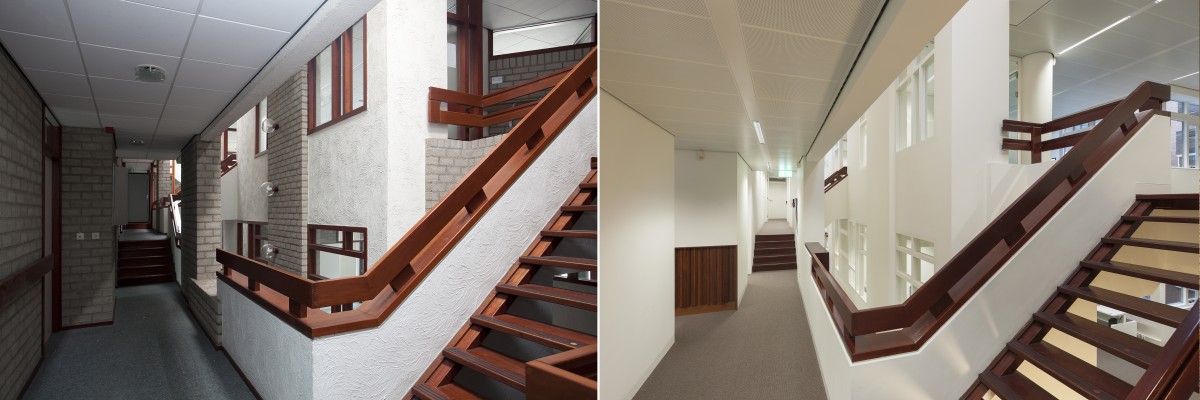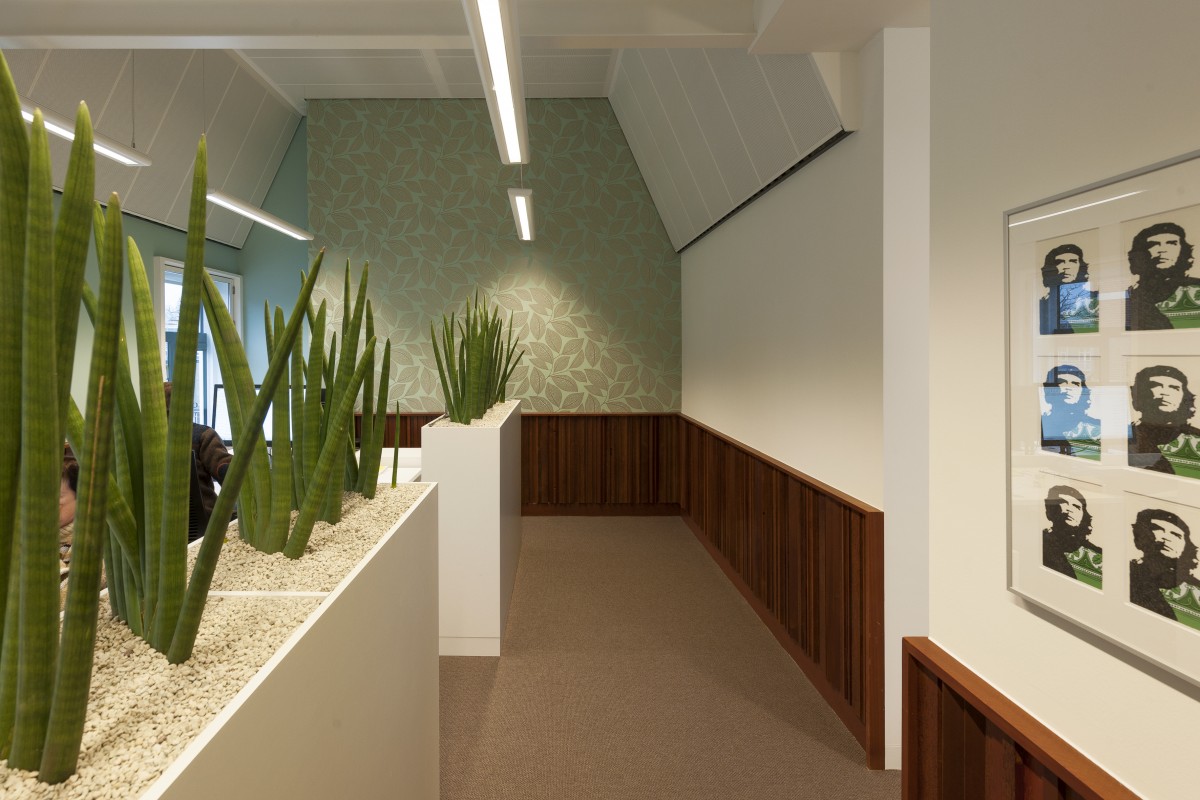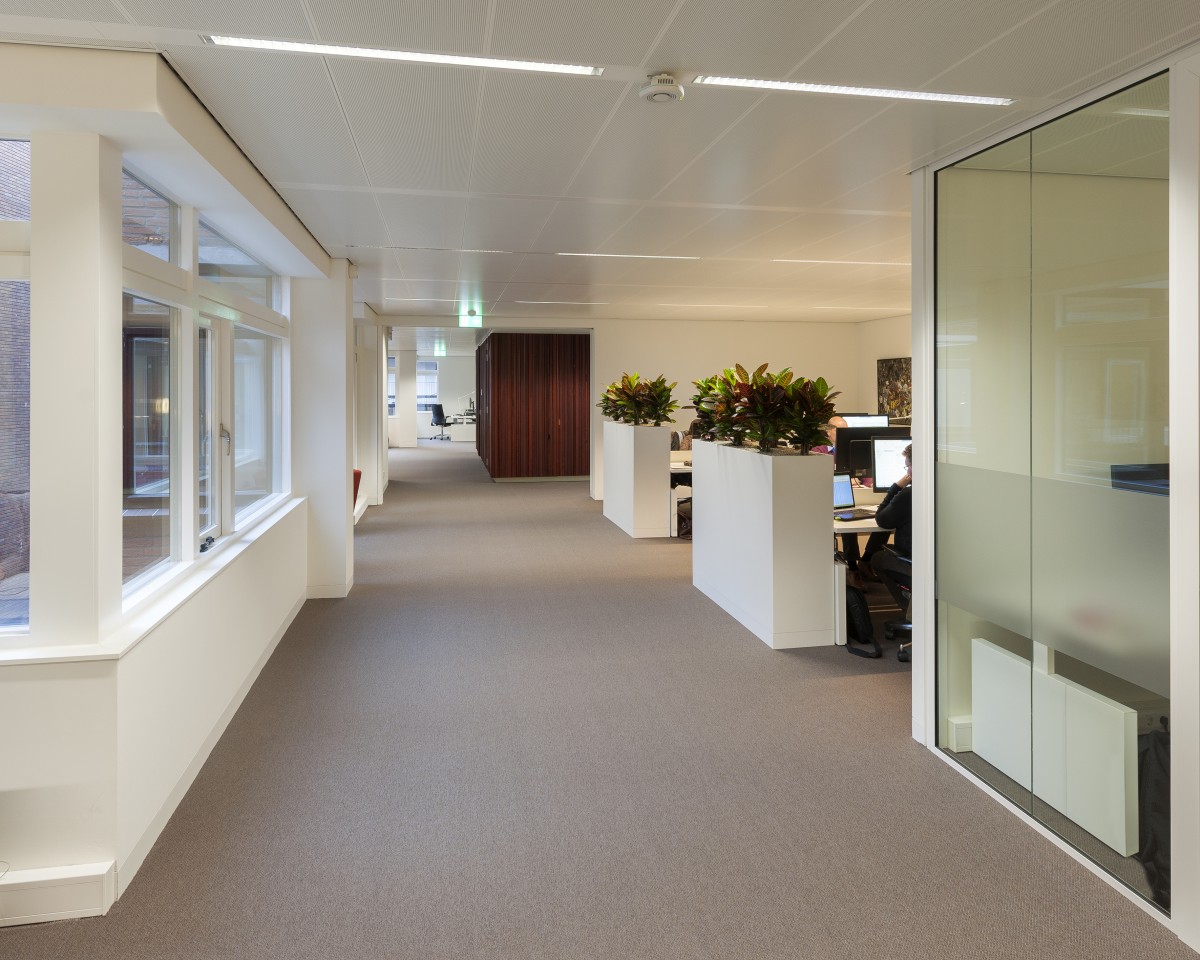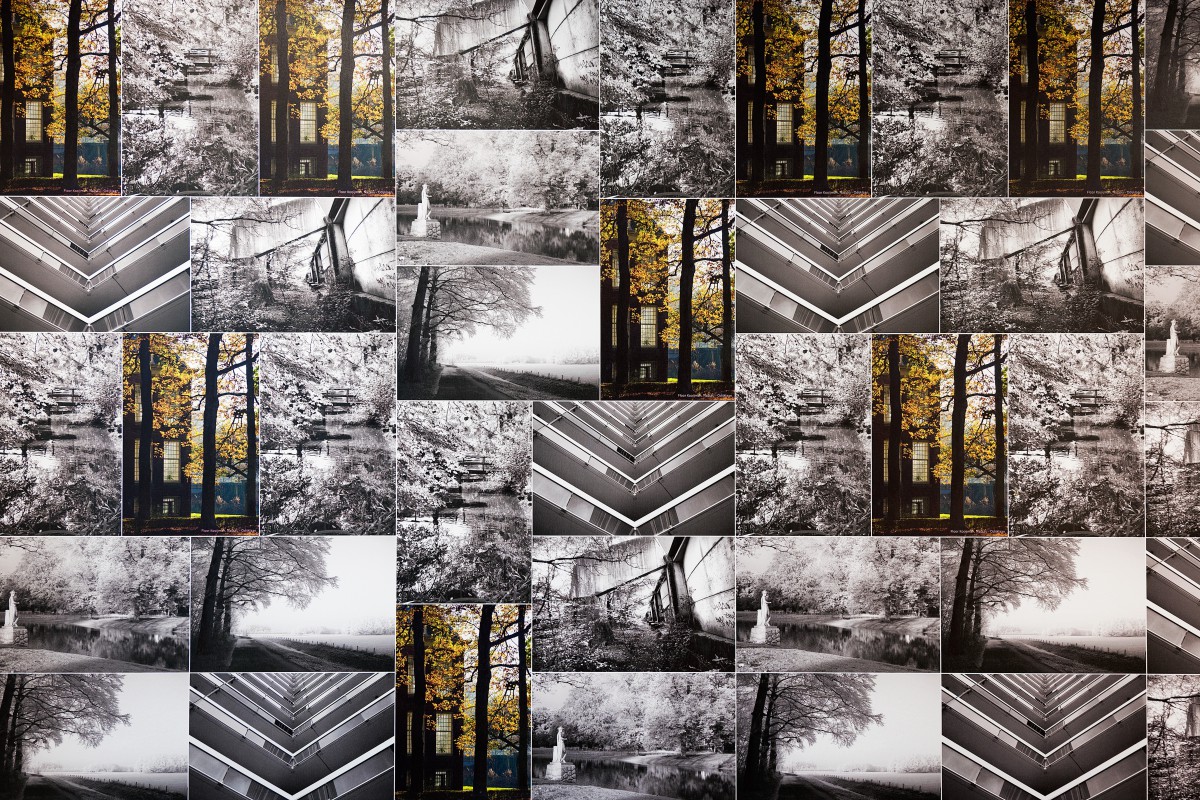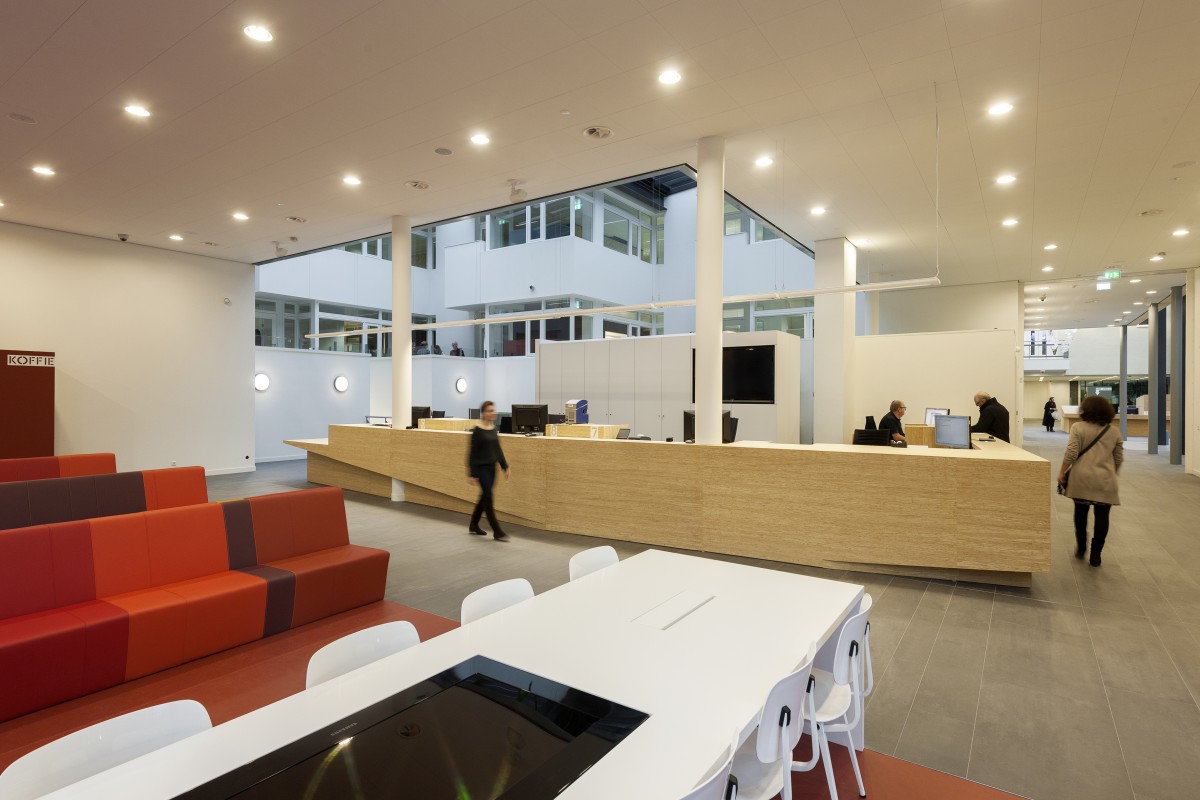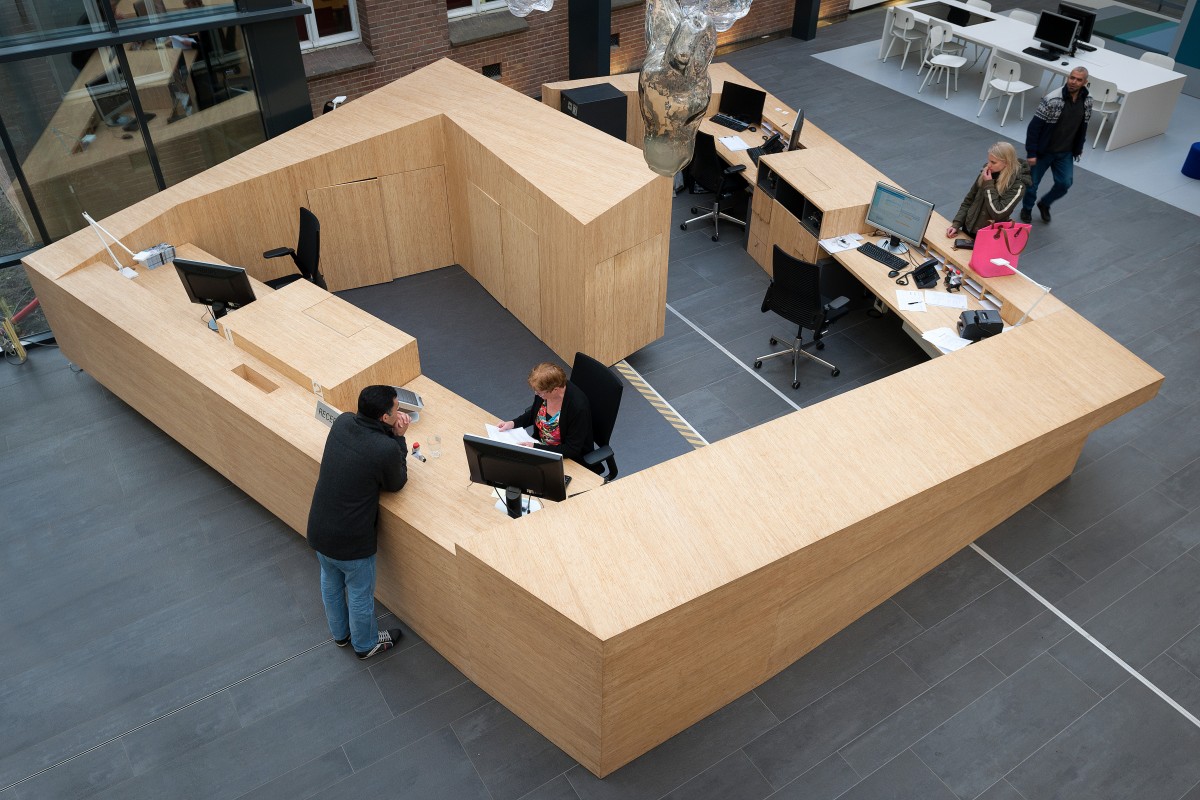A new extended construction has been designed by Rau architects, situated between the monumental townhall from 1908 and the construction (designed by architect Lengkeek) that had been added in the nineteen eightiies. Atelier PRO was selected for renovating the Lengkeek building and the complete interior of the various buildings.
The old town hall has been reupholstered. The Lengkeek building and the adjacent neoclassical buildings on the main street have been converted from a closed room layout into an open layout according to the New Working principles. The entire eighties’ style interior has been removed, except for the existing vertical circulation points and sanitary blocks which are integrated into a service corner with copy machines and a pantry. The color and material of both new and existing interior, have a calm, light and natural look.
Referring to the gentlemen's parlour style, the use of dark wall panels (made out of re-used window frames from the Lengkeek building), coloured walls and wallpaper with nature stylish prints, made the ancient character visible (again) of the historical buildings dated from 1877 situated at the Dorppstraat.
The redeveloped town hall in Zeist unites four generations of town halls in one ensemble. RAU designed the urban plan and the shell of the new connecting volume, while Atelier PRO designed one homogeneous interior for the four generations of buildings and refurbished them to facilitate what is called The New World of Work. Sustainability and respect for the historical surroundings formed obvious points of departure for both the buildings and interior. The renewal of the town hall forms part of the redevelopment of the fourth quadrant that borders Het Rond in the centre of Zeist, the urban design principles of which are reflected in the design of the building.
Urban design context
The street called Het Rond is the birthplace of Zeist. Four urban quadrants border Het Rond, three of which have already undergone redevelopment. The town hall is located in the fourth quadrant, the last to undergo development. A glance at its rich history tells us that every architectural intervention on this site is sensitive. In anticipation of its renewed offices and the redevelopment of the fourth quadrant, the municipality stipulated the preservation of historically significant buildings and urban forms within the plan area. Two important sight lines define the urban plan for the fourth quadrant: the line extending from Eerste Dorpsstraat to Walkart Park, and the line between Het Rond and the church. Restoring these two important sight lines, in the direction of the church and the Walkart Park, formed a key objective of the design. On the edge of the quadrant, the facade of the town hall extends the alignment of buildings along Eerste Dorpsstraat and plays with the existing fragmentation of historical facades, thereby restoring the profile of the historically important Eerste Dorpsstraat.
The new building volume
The new building volume connects the original town hall on Eerste Dorpsstraat dating from 1878, the old town hall from 1908, and the Lengkeek building from 1984. The power of the newly inserted volume lies in its modesty, as reflected in the way it respects the character and scale of existing historical structures. The church and the 1908 town hall are emphasised as cornerstones of the district. Neutral and restrained in appearance, the new volume deliberately adopts a background position, thus forming a subtle decor for the monumental town hall. Housed in the new volume are the new council chamber and restaurant. Inserted between the new volume and the existing buildings is a glazed public hall containing some of the required office space. This hall forms a hinge that links the four generations. Thanks to the transparency of the facade and roof, daylight admission to the existing buildings remains optimal, allowing them to retain their character. Openness and ease of access communicate the public function of the town hall and invite people to use the services on offer. The urban sight lines within the quadrant extend into the design. From the entrance to the town hall, visitors enjoy a view through the public hall and past the new dwellings to the church spire; and from the council chamber, visitors and councillors enjoy a view of Walkart Park. The council chamber reaches to the park, ensuring that the municipal offices connect directly with it just as they did a century ago.
Renovation and interior
Atelier PRO oversaw the rebuilding and renovation of the existing buildings and the refurbishment of the entire project. The aim of the interior design was to create a home for both local residents and municipal employees. Since the building is made up of four sections, each with its own atmosphere, floor heights and routes, the design challenge lay in ‘connecting without losing identity’. The spatial arrangement is based on long lines and through views that harmonise with the sight lines within the quadrant and the atmosphere of green and long avenues so typical of Zeist. The service task in the redevelopment focuses on the future and is based on the slogan ‘The municipality has the answer’, which means that residents come here for all services.
Enlivening the public hall in the new volume, a variety of public functions facilitate contact between the municipality and residents through information desks, waiting and consultation areas, meeting rooms and a reading area. White walls and floors in natural tones exude a sense of calm. Colour defines spaces and enhances legibility and identity. The three waiting areas in the public hall each feature a different colour. Likewise, office areas on each floor are distinguished by the application of a single highlight colour. The age of the buildings on Eerste Dorpsstraat is rendered visible in the interior finishes with references to gentlemen’s rooms with dark panelling, coloured walls and wallpaper with stylized natural prints. The function and interior of the old town hall have remained practically the same, except for the relocation of the council chamber to the new volume and the replacement of electrotechnical installations in preparation for The New World of Work. Thanks to these subtle and purposeful interventions, the former town hall retains its original identity both inside and outside.
Work principles
Staff at the new town hall will work according to a new system in which there are no permanent workstations. Instead, each employee finds a spot that suits the activity of that particular moment. As a result, colleagues come into contact with one another more easily. Part-time employees and those who often work outside the office therefore share the available space, which is thus used much more efficiently. Broadly speaking, one can distinguish three types of work setting in what’s called The New World of Work: concentration workstations, communication workstations and administration workstations. Through the design, materials and positioning of the communication and concentration workstations, a fourth type of workstation has been created for the municipality of Zeist. It’s called the hybrid workstation and lends itself to a variety of activities. Such workstations are mostly used for working between meetings, interacting with a number of people together, and meeting people. To accommodate this new way of working, the entire interior of the Lengkeek building and the oldest section of the building was stripped. In the new arrangement, existing vertical circulation points and sanitary blocks are integrated into a service core that contains printers and a pantry. Since employees no longer have their own personal workstation, places were created where staff can meet one another informally. These so-called living rooms are linked on each floor with the service core containing the toilets, printers, storage units, lockers and pantry. This is the spot with the ‘kitchen table’, the place where birth announcement cards are pinned up, where staff can display a trophy, a place to cut a cake when someone celebrates a birthday.
Development process
The layout and furnishing of the town hall makes it a second ‘home of their own’ for local residents and others who use the ensemble of buildings. From the moment it started to draw up the design brief, the municipality explicitly encouraged employees to participate in the layout of their working environment. Through their involvement in the process, employees now feel more strongly that the building really belongs to them. The Zeist municipal offices and accompanying dwellings and car park was a Design & Build commission awarded to the Kondor Wessels Vastgoed consortium with RAU architects. Atelier PRO received the commission for the renovation of the Lengkeek building and the complete interior of the various buildings. The working relationship between the project partners was smooth because they all shared the same ideas on sustainability, on the careful treatment of heritage, and on transformation processes in the existing city. OLCO, a firm of advisors specialising in community real estate, supervised the process from procurement to completion.
Sustainability
Construction of a sustainable building was one of the most important requirements set by the municipality, which is in part why RAU and Atelier Pro landed the commission. Sustainability was a motive in the choice of technology, materials and items of furniture. Energy-efficient techniques, a thermal energy storage system, natural materials such as bamboo, on-spot work illumination, cradle-to-cradle floor coverings, and wallpaper made of recycled paper: these are just some of the choices made in the area of sustainability. The most striking choice involved the reuse of window frames from the Lengkeek building as wall panelling and storage walls. For Atelier Pro the reuse of existing buildings was an obvious choice. The existing and reused components of the town hall are fitted with a new layer of insulation. Old glass was replaced by HR++ glass, while double windows are added to the historical facades. The roof of the Lengkeek building is fitted with new insulation and finished with vegetable-based white roof sheets that are environmentally friendly and reduce heat absorption. Before the commencement of the redevelopment, the existing town hall had an Energy Label G. The new municipal offices have now been reassessed and, thanks to the sustainable technology and materials applied, boast an Energy Label A.

